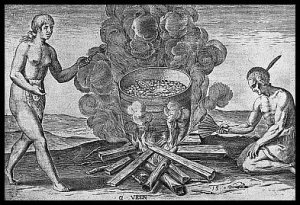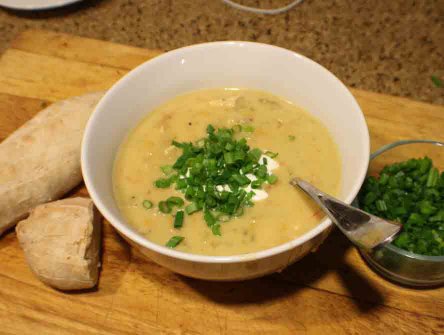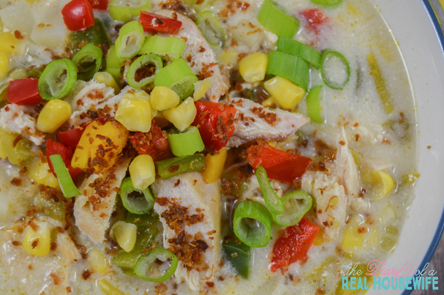| Not just a variation on Clam Chowder..
| 
|
In the United States this is a very common soup to see in restaurants and heartwarming to prepare on cold and rainy days. It smells wonderful simmering on the stove.
When you think about your Chicken in the pot simmering the idea of adding potatoes and corn seem like perfect comfort foods, then thicken it to make a creamy, silky smooth meal. |

|
 |
The roots of this dish are two fold. First a chowder comes the French pot called a Chaudiere which is a similar word for a Cauldron. These pots were often on fishing vessels that simmered some of the catch and thickened probably with hard soda style crackers.
Settlers from fishing villages in Europe that immigrated "across the pond" brought this tradition with them and it has carried on since. |

|
Corn and Corn Soup, Definitely Native-American

The corn comes from the Native Americans that grew corn and made corn soup. This was shared with the early settlers.. Corn was not only a wonderful thing to add to a soup for flavor but also to thicken.
Corn also meant survival Corn was a food that was dried ( look like popcorn kernels) and in the winter before freezers and canned foods was reconstituted and made into comforting foods like soup, and was a great sweetner for all the odd meats that they had to survive on.
Pennsylvania Dutch Specialty
"I first had chicken and corn soup when visiting a Midwest farm as a youngster, but many people think one must go to the source to taste the real flavor of this all-American pottage. Chicken and corn soup as made in Pennsylvania is a thick combination of pungent buts of simmered chicken with kernels from freshly picked corn and egg noodles rolled out while the saffron-flavored broth is brewing; it brings tourists from far and near to Lancaster County and other parts of Pennsylvania Dutch country for church suppers and outdoor food festivals."
---American Food: The Gastronomic Story, Evan Jones, 2nd edition [Vintage Books:New York] 1981 (p. 86)
from the food timeline
Vintage Corn Soup and Chowder Recipes
 
Iroquois Foods and Food Preparation
"Parched Green Corn Soup.
Green corn, when nearly ripe, is gathered, roasted on the cob before the fire, or on top of the stove, then shelled, dried over the stove, or in the sun, in an evaporating basket...then put away in a bag or barrel for future use. Grain prepared in this manner is called...'dried parched corn.' To cook, place a quantity of the corn in a kettle, and boiling water and boil for half an hour, drain, add fresh water, then some kind of meat. Boil for an hour and season with salt. Another way of seasoning is to sweeten."
---Iroquois Foods and Food Preparation, F.W. Waugh, facsimile 1916 edition [University Press of the Pacific:Honolulu HI] 2003 (p. 96)
Pennsylvania Dutch recipe
 
Domestic Cookery, Useful Receipts, and Hints to Young Housekeepers
[1853]
Chicken Stewed with New Corn.
Cut up the chickens as for pies; season them well; have green corn cut off the cob; put a layer of chicken at the bottom of a stew pan, and a layer of corn, and so til you fill all in; sprinkle in salt, pepper and parsley, and put a piece of butter in; cover it with water, and put on a crust, with slits cut in it; let it boil an hour; when done, lay the crust in a deep dish; dip out the chicken and corn, and put it on the crust; stir in the gravy a thickening of milk and flour; when this boils up, pour it in with the corn and chicken. Chicken and corn boiled together in a pot, make very nice soup, with dumplings."
---Domestic Cookery, Elizabeth Ellicott Lea, facsimile 1853 edition, with notes by William Woys Weaver [Stackpole Books:Mechanicsburg PA] revised edition, 2004 (p. 29)
from the food timeline
~~~~~~~~~~~~~~~~~~~~~~~~~~~
Lower fat and lower carb way to thicken the chowder
There is a great way to thicken a soup without using flour or flour and oil if you are looking to decrease the fat content.The calories per 2 cup bowl are going to be in the 300's and maybe 8-10 grams fat.You will get dang near the same texture as you would with a butter roux

I put the cooked Yukon gold potatoes in the blender with
a little chicken stock

Blend for a good 30 seconds to a minute to get that really
smoothe shiny creamy thick texture. that feels so good on
your tongue.
This is a non fat , gluten free way to thicken your chowder.
Corn Chowder Recipes

Chicken Corn Chowder
with shredded chicken breast
~~~~~~~~~~~~~~~~~~~~~~~
Chicken Corn Chowder 
Diary of a Real Housewife
~~~~~~~~~~~~~~~~~~~~~~~~~~~~~~~~~~
Cooking Light's Quick Chicken Corn Chowder 
Curried Chicken Corn Chowder 
~~~~~~~~~~~~~~~~~~
Tex Mex Chicken Corn Chowder

|























